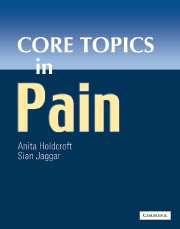Book contents
- Frontmatter
- Contents
- Contributors
- Preface
- Acknowledgements
- Foreword
- General abbreviations
- Basic science abbreviations
- PART 1 BASIC SCIENCE
- PART 2 PAIN ASSESSMENT
- Section 2a Pain measurement
- Section 2b Diagnostic strategies
- PART 3 PAIN IN THE CLINICAL SETTING
- Section 3a Clinical presentations
- Section 3b Pain syndromes
- 19 Myofascial/musculoskeletal pain
- 20 Neuropathic pain
- 21 Visceral nociception and pain
- 22 The management of low back pain
- 23 Cancer pain
- 24 Post-operative pain
- 25 Complex regional pain syndrome
- 26 Uncommon pain syndromes
- 27 Pain in children
- 28 Pain in the elderly
- 29 Gender and pain
- PART 4 THE ROLE OF EVIDENCE IN PAIN MANAGEMENT
- PART 5 TREATMENT OF PAIN
- Section 5a General Principles
- Section 5b Physical treatments
- Section 5c Pharmacology
- Section 5d Psychosocial
- PART 6 SUMMARIES
- Glossary
- Index
24 - Post-operative pain
from Section 3b - Pain syndromes
Published online by Cambridge University Press: 10 December 2009
- Frontmatter
- Contents
- Contributors
- Preface
- Acknowledgements
- Foreword
- General abbreviations
- Basic science abbreviations
- PART 1 BASIC SCIENCE
- PART 2 PAIN ASSESSMENT
- Section 2a Pain measurement
- Section 2b Diagnostic strategies
- PART 3 PAIN IN THE CLINICAL SETTING
- Section 3a Clinical presentations
- Section 3b Pain syndromes
- 19 Myofascial/musculoskeletal pain
- 20 Neuropathic pain
- 21 Visceral nociception and pain
- 22 The management of low back pain
- 23 Cancer pain
- 24 Post-operative pain
- 25 Complex regional pain syndrome
- 26 Uncommon pain syndromes
- 27 Pain in children
- 28 Pain in the elderly
- 29 Gender and pain
- PART 4 THE ROLE OF EVIDENCE IN PAIN MANAGEMENT
- PART 5 TREATMENT OF PAIN
- Section 5a General Principles
- Section 5b Physical treatments
- Section 5c Pharmacology
- Section 5d Psychosocial
- PART 6 SUMMARIES
- Glossary
- Index
Summary
Incidence
In 1990, The Royal College of Surgeons (RCS) report ‘pain after surgery’ found 30–70% patients with moderate or worse pain after surgery. A recent review finds that although the incidence of post-operative pain has reduced by ~2%/year for the last 30 years, 30% of patients still complain of moderate pain and 11% severe pain.
Factors affecting the severity of post-operative pain
Expected pain and analgesic requirements following surgery are extremely variable:
Type of surgery
Size of the wound, amount of tissue damage.
Muscle cutting or splitting incision.
Technique, delicacy of dissection and retraction, type of stitch.
Site of surgery
Movement of damaged tissues (e.g. chest and upper abdominal surgery).
Oedema in a confined space (e.g. total knee replacement).
Patient factors
Age, sex, medical condition and emotional state.
Reason for/outcome of surgery.
Other sources of distress: nausea, sleeplessness, noise.
Home circumstances, anxiety about family, work.
Cultural background
Attitudes to illness, treatment and pain.
Advantages of effective treatment
The fundamental imperative to treat post-operative pain is humanitarian; ‘It is the basic duty of all health care professionals to relieve pain’ RCS Report on Pain after Surgery 1990. We should not tolerate people suffering pain when effective treatment is readily available.
- Type
- Chapter
- Information
- Core Topics in Pain , pp. 161 - 170Publisher: Cambridge University PressPrint publication year: 2005



